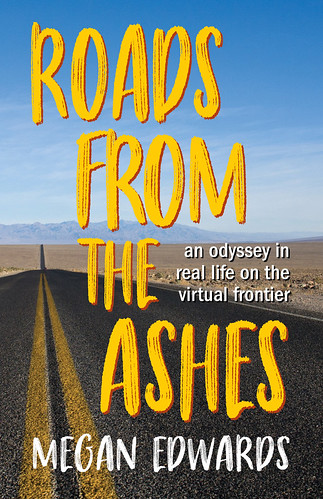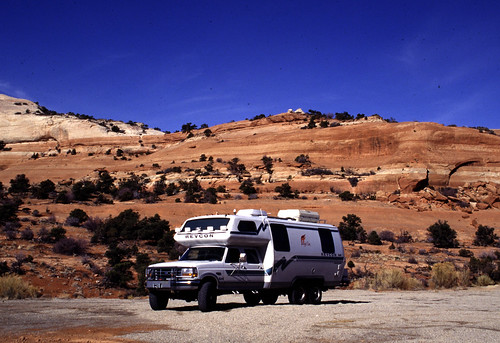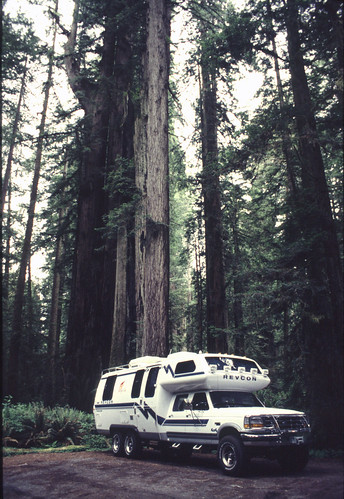What a difference twenty years makes. When an intuitive, resourceful, creative couple lost everything in the devastating California wildfires of '93, they didn't wallow. They hit the road. Along the way, a literal journey became a metaphorical journey and they found freedom devoid of material items. A motorhome became their chariot, and the then-new Internet became their connection to finding their future.
Today, twenty years later, Megan Edwards' on-the-road memoir, Roads From the Ashes: An Odyssey in Real Life on the Virtual Frontier, resonates just as powerfully, if not more so than it did when first released. To mark the 20th anniversary, publisher Imbrifex Books released a new e-book edition on December 1. With a new introduction by Edwards and a foreword by Chris Epting, the story takes readers on an armchair adventure across North America when the Internet was young. The new edition also includes 22 photos from life on the open road.

Megan's engaging storytelling is powerful not just from the humor and honesty, but from the vivid details that bring this journey to life. The coast-to-coast trek is what many will do for a vacation, but this time it's about survival, rebirth, and renewal. But it's also a travelogue and like any good travel tome, this one places you right in the front seat, squeezed between the two of them as you visit majestic places far and wide, ocean to desert to forest to the Big Apple. As the world becomes aware of them and the media start taking notice, we are there as their lives change.

Moab-Slickrock-1-UT
Here’s an excerpt from the book, with original photos:
On the Road and Online
Buffalo Shadow

The Three Ms
Our first personal interview as Internet journalists took us to Jacumba, a small town just north of the Mexican border in the desert east of San Diego. We had an appointment to talk to an old-timer, a prospector named Don Weaver who had scoured the hills for decades in search of tourmaline and gold. Our directions were the kind that took us off the map on a dirt road and included large objects as landmarks: “Go past the pile of rocks,” and “Fork left at the big cactus.” With little effort, we were soon lost in the border zone, and it wasn’t long before we arrived at a landmark that caught us wholly by surprise. It was a huge wall built of steel girders and concrete pilings. Topped with a thorned crown of razor wire, it was clearly a project with no less a goal than to form an impassable barrier between the United States and Mexico. I hadn’t seen anything like it since I visited East Germany in the seventies. “I can’t believe it,” I said as we came to a halt in front of the forbidding structure. “I can’t believe this exists in the same country that spent so much time talking about how awful the Berlin Wall was.” But there it was, and the only difference was that this unsightly edifice, probably because of its isolated location, had managed to avoid the nightly news.
We turned around in a clearing in front of the wall and headed back the way we came. A hundred yards back up the road, three men had emerged from a house to take a look at our alien vehicle. We stopped, and Mark asked for directions. All three knew where Don Weaver lived, and, armed with a new set of landmarks, we set out afresh. This time, we reached our destination without detour, and a gray-haired lady in a flowered blouse came outside to greet us. “I’m Grace Helen,” she said. “Come on up.” We followed her up several stone steps to a patio covered by a blooming bougainvillea vine. “Don will be right out,” said Grace Helen. “Please sit down.” We sat, and soon Don appeared, hobbling painfully on a cane. “Hello,” he said gruffly. “If I’d known how to reach you, I would have told you not to come.” Taken aback, I said, “If this isn’t a good time, we can leave.” “No, no, you’re here,” said Don as he lowered himself into a folding chair. “It’s just that I slipped yesterday and landed on my hip, and I’m just not doing very well. But you’re here, so tell me what you want to know.”
This was our first serious interview, the first time we’d called someone up, identified ourselves as being with “RoadTrip America, a feature magazine on the World Wide Web.” We didn’t find ourselves speechless, but we were hardly seasoned. Since Don Weaver was a prospector, it seemed only reasonable to start out asking questions about rocks and mines and ore. It didn’t take long before our conversation had gone beyond pegmatite dykes and quartz outcroppings. As Don relaxed into story-telling mode and realized his audience was genuinely interested, he told us about a rock crushing mill he built in 1951 at a place over the border called Dos Cabezas.
He used the now-defunct San Diego & Imperial Valley Railroad to ship white limestone to roofers in Southern California. The railroad had been completed in 1919 at enormous expense by the Spreckels sugar dynasty over terrain so treacherous it was called the “impossible track.” It took 16 major tunnels and 21 trestles to complete the run from Mexico to California, and the wooden span over Goat Canyon still holds the world record for length and height. “It wasn’t easy to use that railroad, but it was too hot to use trucks, and the road was too bad,” Don said. “It was hard to keep workers, too,” he added. To make things a little easier, he invented and built a portable mill that he could move from location to location.
Don went on to tell us about other businesses he’d owned and prospecting he’d done all over the Southwest. He told us how he’d discovered gold in Arizona, and sold a lucrative option on his claim. “They never did anything with it, though,” he said. “The gold’s still there. I could take you right to it.” By this time, we were all feeling more comfortable, and I asked Don about his childhood. His eyes immediately took on a faraway look. “I was born on the Cimarron River in a plum thicket,” said Don. “Renegades were chasing my parents. After my mother had me, my father said, ‘Leave that little spotted pony for Don. He’ll catch up with us.’” The story progressed, and before our eyes Don Weaver, the prospector, disappeared. In his place, a new personage emerged, a regal, powerful one.
Where just a few minutes before an ancient prospector had sat crippled in pain, we found ourselves gazing upon Buffalo Shadow, the Delaware Indian chief.
Suddenly he rose, and with vigor he hadn’t possessed when we arrived, he disappeared into the house. In a few minutes, he returned with two long wooden cases. He opened the first and removed a long peace pipe carved from smooth dark wood. “This is my chief’s pipe,” he said, “My calumet.” As we admired its exquisite craftsmanship, Buffalo Shadow opened the other case. “And this is my jewelry,” he said, holding up a heavy necklace made of carved bone, beads and polished stones. “Can you put it on?” I blurted. I looked at Mark nervously. Was that a rude thing to ask? But Buffalo Shadow didn’t seem to mind. He fastened the heavy necklace around his throat and sat down.
Before we had a chance to print and mail a copy of the story, we received a telephone message. Buffalo Shadow had seen the story online, he said, and thank you. And thanks for coming, and safe journey. “Looks like Buffalo Shadow caught up with us,” said Mark, “And we didn’t even leave him a spotted pony.”
The week after the story appeared on RoadTrip America, we received an appreciative e-mail message from the chief’s niece in Colorado. We had an invitation to visit a nephew who lived on the Olympic Peninsula in a bear preserve, and another to meet the artist in Tucson who made our calumet. Not only did this unexpected and far-flung response reinforce our belief that the interactivity of the World Wide Web imbued it with connective powers we had yet to fully appreciate, it shattered an assumption I’d hit the road with. Without giving the subject second thought, I had assumed that people in isolated places would be the last to find connection to the Internet.

LAT-Nicovan
Buffalo Shadow was my first inkling that the opposite might be true. Just as you’re more likely to find an airplane parked next to a cabin in Alaska than beside a suburban split level in Chicago, I soon learned that the appeal of electronic communication was stronger in the boondocks than it was in Manhattan.
Before we left Pasadena as RoadTrip America, we’d emblazoned the Phoenix One with new graphics heralding our Internet presence. On both sides, we included that mysterious and cutting edge code, our address on the World Wide Web. For most of 1996, we never saw another URL on a vehicle, and ours attracted attention wherever we went. It’s the primary way we learned never to predict who was wired and who wasn’t. In those days, a power dresser with a cell phone could easily be an Internet illiterate, and a rube in a straw hat might be a cyber pro.

Redwoods NP
Megan Edwards is the co-founder of RoadTrip America® and author of the travel memoir Roads from the Ashes, the humor book Caution: Funny Signs Ahead, two Copper Black mystery novels Getting off on Frank Sinatra and Full Service Blonde, and a romantic novel, Strings. She has lived and traveled extensively in Europe and spent over six years "on the road" all over North America. Now at home in Las Vegas, Nevada, she is working on her next novel.
For more information, visit MeganEdwards.com or Imbrifex.com and connect with Megan on Facebook, Twitter, Instagram, and Goodreads.

Red Rock Canyon Road Summit
All photos courtesy and copyright Megan Edwards
